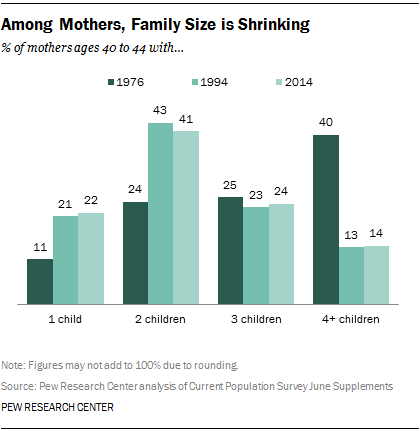
In the late 1970s, the average mother at the end of her childbearing years had given birth to more than three children. Since that time, average family size has declined, driven largely by declines in families with four or more children. Now, moms have 2.4 children on average – a number that has been fairly stable for two decades.
In 1976, four-in-ten mothers ages 40 to 44 had four or more children. One-fourth had three children, and a similar share (24%) had two children. Only 11% of mothers at the end of their childbearing years had had only one child.
Flash forward to 2014, and the situation has changed dramatically. The once-dominant four-child family has been replaced by the two-child family. A plurality (41%) of moms at the end of their childbearing years now report having two kids, while just 14% have four or more children. Meanwhile, the share of mothers at the end of their childbearing years who have one child has doubled – from 11% to 22%. As has been the case for many decades, about one-fourth of mothers have three children (24%).
Most of the change in family size occurred between 1976 and the mid-1990s. Family size since that time has remained quite stable.
Number of Children, by Educational Attainment
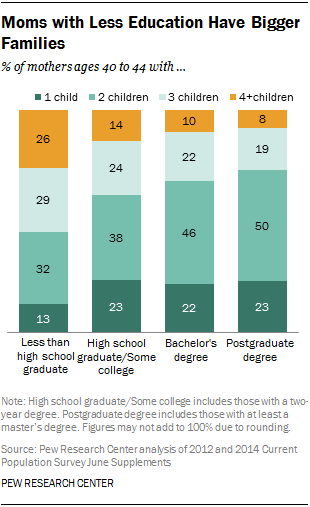
The more education a mother has, the fewer children she will have on average in her lifetime. While fertility drops somewhat with each additional level of education, the biggest fertility gap occurs between women who lack a high school diploma and those who have completed high school.
Moms ages 40 to 44 who lack a high school diploma have about 2.9 children in their lifetimes, on average, while those with a high school diploma or some college have about 2.4 kids. Mothers at the end of their childbearing years who have a bachelor’s degree or higher have about 2.2 children on average.
The two-child family is the most common family type among moms with a high school diploma or more, and it is particularly prevalent among women with a bachelor’s degree or higher. Some 46% of women ages 40 to 44 with a bachelor’s degree have two children, as do half of those with at least a master’s degree. One third (32%) of women who lack a high school diploma have two children, as do 38% of those with a high school diploma or some college experience.
More than half (55%) of mothers who lack a high school diploma have three children or more – 29% have exactly three children, and 26% have four or more. The likelihood of having such large families declines markedly at higher levels of education. Among mothers with a high school diploma or some college experience, 24% have three children and another 14% have four or more children, while about one-third (32%) of mothers with a bachelor’s degree have three or more children. Meanwhile, mothers with advanced degrees are half as likely as those lacking a high school diploma to have three or more children – just 27% do. Some 19% have three children, and 8% have four or more.
While the association of education and family size remains a strong one, in fact the educational “gap” in fertility has narrowed in the past two decades, driven in part by increases in family size among the highly educated.
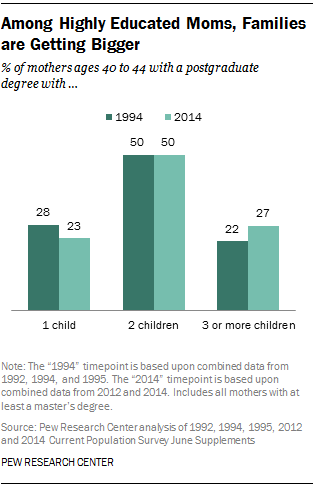
Since 1994, the share of mothers with at least a master’s degree who have just one child has declined from 28% to 23%. At the same time, the share having three or more children has increased from 22% to 27%. Highly educated women are the only group in which this clear pattern emerges, with a declining share having one child and a rising share having three or more.
Among mothers who lack a high school diploma, the share having four or more has declined by 5 points, while the share having exactly three children has increased by 5 points. There has been little change in the share with fewer children.
Interestingly, among mothers with a high school diploma, the share having two children has declined by 5 percentage points, down from 43% in 1994. This decline is accompanied by an increase in the share having just one child.
Fertility patterns have remained virtually unchanged since 1994 for mothers with a bachelor’s degree.
Fertility Patterns Among Mothers by Race and Ethnicity
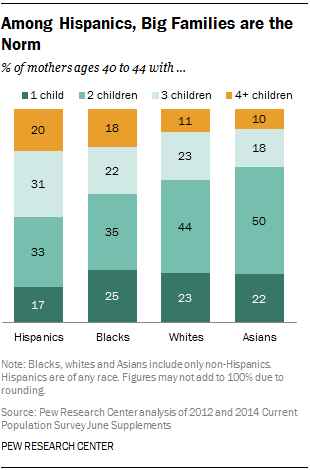
Among mothers near the end of their childbearing years, Hispanics and blacks have the largest families. On average, a Hispanic mother ages 40 to 44 has had about 2.6 children. By comparison, black mothers have had about 2.5. White and Asian mothers have families that are a bit smaller, on average. White mothers have 2.3 children, and Asian mothers have 2.2 children.
When looking at the distribution of family size by race and ethnicity, the distinctiveness of the Hispanic family becomes particularly apparent. Among mothers ages 40 to 44, Hispanics are the least likely to have only one child – just 17% do. In contrast, fully 25% of black moms have had just one child, as is the case for 23% of white moms and 22% of Asian moms.
Conversely, Hispanics are far more likely than others to have large families. Fully half of Hispanic mothers have three or more kids, compared with 40% of blacks. About one-third (33%) of whites have three or more kids, and just 27% of Asian moms do.
Among whites, blacks and Asians, having two children is the most common outcome for mothers. Asian moms are the most likely to have two children – fully half do. Some 44% of white moms ages 40 to 44 have two children, as do about one-third of black moms.
Looking at changes in fertility over time, it’s apparent that families with four or more children are in decline for whites, blacks, and Hispanics. However, there are variations in which family sizes are “gaining ground” as very large families are on the wane.
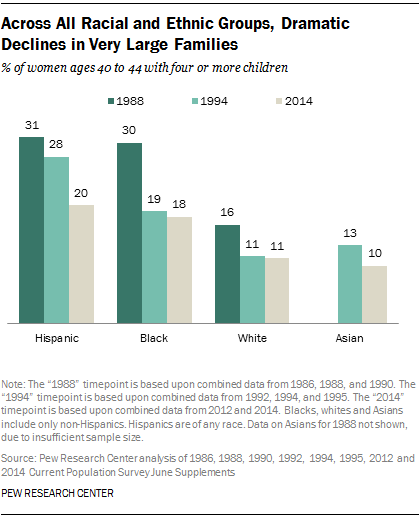
The decline in the share of moms with four or more kids has been particularly dramatic among black mothers. In 1988, three-in-ten black mothers ages 40 to 44 had four or more children, but by 2014, just 18% did. At the same time, the share of black mothers with one child rose by 5 percentage points (from 20% to 25%), as did the share with two children.
The decline in the share of mothers with four or more children has been notable among Hispanics as well. In 1988, fully 31% of Hispanic moms had four or more children. That share dropped to 20% by 2014. At the same time, there was an 8-percentage-point increase in the share of Hispanic moms with exactly three children – suggesting that many mothers were opting for three kids instead of four or more.
Among white mothers, the 6-point decline in families with four or more children has been totally offset by the 6-point rise in only children.
Data on Asian mothers are unavailable for 1988, but since 1994, there has been no significant change in the size of their families.




